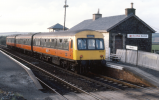Used to see both the ScR 117 and 305s in the Edinburgh area from the train when going to/from the Grandparents in Dundee, though sadly never got the chance to do either. My Granddad did take a few photos of the 305s, seen a few while going through his old photos.
I believe WAGN 317s were earmarked to replace the 305s in the late 90s with the problems surrounding introducing the 334s meaning 318s couldn’t be displaced in time…at least one of the magazines mentioned it was on the cards. 322s arrived instead, the first time around in late 2001/early 2002, as WAGN couldn’t afford to lose 4 or 5 317s when they were sweating them enough as it was!
I recall one rather frustrated person wrote into RAIL magazine expressing their anger about valuable Sliding Door EMUs being pinched from WAGN to replace the 305s, his suggestion was the slightly younger Class 310s should have replaced the 305s until suitable stock became available!

